
Sid Meier's Civilization computer game seems ripe for conversion into a board game. The PC game is, after all, basically just a computerized board game that plays out on a grander scale. Sid himself was inspired by many classic board games, including Risk and Axis & Allies. Fantasy Flight has already taken a stab at trying to distill the core mechanics of Civ down into a digestible board game when they released Sid Meier's Civilization: the Board Game back in 2010. I really like that game, even though it is a bit bloated and unwieldy. Attempting to directly translate Civ's mechanics down into board game form unsurprisingly results in a fairly complicated game that takes a very long time to learn and play.
Fantasy Flight's approach this time around seems to be to develop an elegant board game, and then apply the Civilization license onto it. The result is a board game that feels much more distant from the computer game, but which plays much more smoothly as a board game.
Civilization, streamlined
Perhaps the biggest problem with the older Civilization board game is the game length and amount of downtime. Games could run for over five hours, and the fact that each player resolved their entire turn phase (city management or army movement) before moving onto the next player meant that you could end up sitting for 20 to 40 minutes, twiddling your thumbs and waiting for other players to resolve their turns. That is one of my biggest peeves with a lot of epic games: too much downtime.
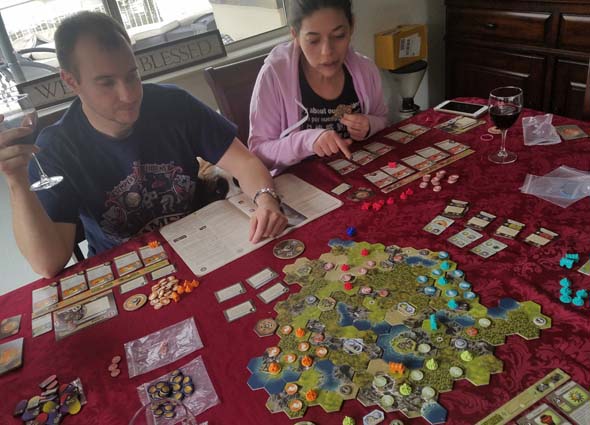
A New Dawn is a very elegant game.
A New Dawn addresses that problem by having each player take only a single action in each of their turns. There are no phases; just take an action from your focus bar and then move on to the next player. Turns, therefore, are very quick, turnaround time is very short, and the game moves along at a rapid pace. This, ironically, serves to better maintain the "one more turn" addictive nature of the computer game. You might find yourself neglecting bathroom breaks for several turns because things are moving along so swiftly. Your turn is generally quick enough that you want to finish it before you step away or take a break, and other players' turns are so quick that you don't want to step away because you know it'll be back around to your turn in a few minutes.
Longer games with longer turns and more downtime can also often result in players outright forgetting what they were planning on doing by the time the turn gets back around to them. Either that, or the large amounts of moves and actions that the other players take changes the game state so much that, when your turn comes around, the thing you were planning on doing is no longer ideal -- if it's even possible.
That's rarely a problem in A New Dawn because each player does one thing on their turn, so the state of the board isn't radically changing between your turns. It's much more of a gradual change. That doesn't mean that other players can't disrupt your plans; they certainly can, especially when combat between players starts happening. It just means that you aren't going to be sitting there bouncing up and down in your chair waiting to pull off a spectacular move, only to have another player blow up all your plans at the last minute and leave you spending far too long wondering "What the heck do I do now?" when your turn starts.
A more focused game
The nature of the game's novel "focus bar" also helps to speed things along and help with planning out your turns because it acts as a sort of roadmap for what you should be trying to do. The focus bar consists of five cards, which each represent some aspect of your civilization: economy, research, industry, culture, and military. Each card's location in the focus bar determines its relative strength and affects what exactly is possible to do with that card. Each slot on the focus bar corresponds to a terrain type, which escalate in "difficulty level", with grasslands being the easiest and mountains being the hardest. Playing a card at a given position in the focus bar generally allows you to take actions that affect tiles of the corresponding terrain difficulty or lower.
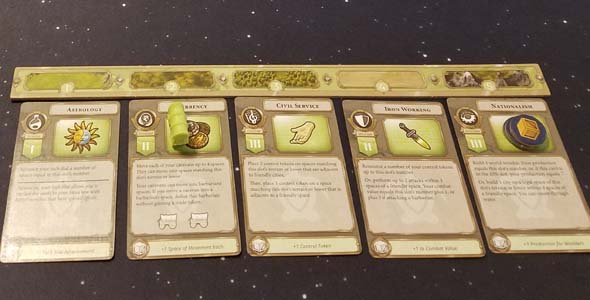
The focus bar guides your actions.
If you play your industry card at position 3 (forest), then you are restricted to building new cities on grasslands, hills, or forests. If you wait until the card is at position 5 (mountain), then you can build your shiny new city on any non-water tile, including valuable mountains. Similarly, control tokens can only be placed on terrain that is as easy (or easier) than the culture card's corresponding location on the focus bar, caravans can only move through terrain that is as easy (or easier) than the economy card's corresponding location on the focus bar, and so on.
The catch is that whenever a card's action is played, that card goes all the way back down to position 1, and every card that was behind it shifts up a position in the queue. If you play your culture card at position 5 to claim a resource on an elusive mountain tile, then the culture card goes back down to position 1, and you'll have to wait before you can claim any more difficult mountain tiles. Of course, if you don't need to claim any more mountain tiles, and only need, say hill and forest tiles, then you can play your culture card at position 3 without having to wait for it to make its way all the way back up to 5.
In some ways, this can feel like the game is occasionally railroading you into making certain decisions, since the starting position of each focus card is determined by your specific civilization, and you generally want to use the card in the fifth or fourth slot whenever possible in order to be as efficient as possible. Despite this, there is still a tremendous amount of options and freedom to the player. Several focus cards give you the choice of one of two or three different actions that you can take. For example, the industry card allows you to found a new city or build a world wonder, and the military card lets you make up to two attacks against enemy targets or reinforce a number of your control tiles to make it harder for other players (and barbarians) to attack you.
The pace of play is also aided by a few other design abstractions and omissions. For one thing, the entire board is revealed from the start. There is no "fog of war" or exploration phase in this game. You go right into growing and expanding your cities and claiming resources.
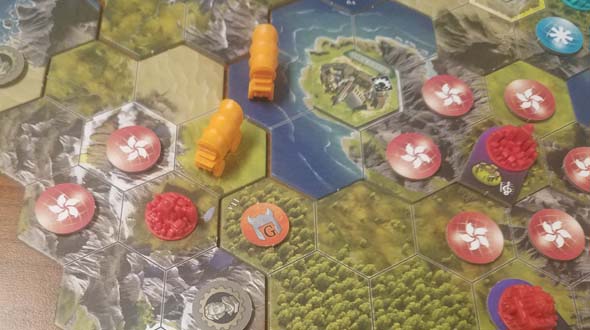
There's no unit or army movement at all.
Traders and barbarians are the only pieces that move across the board.
There's also no army or unit movement at all. Instead of having armies that move around the board and battle when they share a space, combat is a much more abstract concept of attacking from one space that you control to another space that an enemy controls, within a range determined by your civilization's military development. Combat is resolved by simply rolling competing die checks, then adding any modifiers that the participants get (based on tile difficulty, civilization bonuses, fortification, wonders, and so on). The participant with the higher total wins the combat (ties go to the defender). It's really quick and simple.
There are still barbarians in the game, and they (along with trade caravans) are the only pieces that actually move across the board. The barbarians can actually be quite brutal too, so you need to be sure to devote some effort into neutralizing them or else they will wreak havoc on your civilization.
Map and civilization balance
It could be a lack of experience, but the civilizations do not feel particularly balanced against each other. Leaders like Cleopatra (Egypt), Catherine (France), and Trajan (Rome) seem rather weak. Others, like Hojo Tokimune (Japan) and Tomyris (Scythia), have very circumstantial powers that will depend on the map layout or the specific situations. But then there's Montezuma (Aztecs), Gilgamesh (Sumeria), and Teddy Roosevelt (America), who have very strong powers that can be used more consistently throughout the game. Maybe I just need to play more and find better ways to use the seemingly-weaker civs' powers.
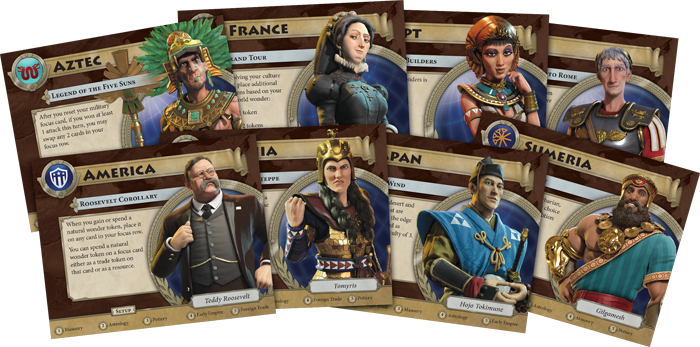
Some of the civilizations seem decidedly superior to others.
The map itself also seems to be a bit unbalanced. Even the default "learning game" map puts civ capitals at varying distances from each other, and puts some capitals only a stone's throw away from multiple barbarians. There's also rules for creating your own map, in which each player takes turns putting down map tiles. I don't recommend trying this unless everyone playing has already played one or two games.
Despite the elegance of the game's design, there were a few rules issues in the first few games that were not cleared up by re-reading the rules. The most significant open issue was the question of whether cities count as "controlled" tiles (for the "Explorer" victory objective, for example). We assumed that cities count as "controlled" territory, but (despite having an entire page dedicated to definitions) the rules do not at any point clarify or define the term "control".
There were a few other minor rules issues that I think we got clarified.
What happens after a barbarian attacks a capital? Does it stay on the city tile (similar to when a barb attacks a city state)? (Yes).
Can we use multiple copies of the same resource to build wonders? (Yes).
Do terrain restrictions apply to free bonus actions (such as setting down additional control tiles granted by wonders or other effects)? (No).
Can Roosevelt re-use a single natural wonder token in the same turn? (verdict's still out).
And so on. While it's nice that the rulebook is short and simple, it would have been nice to have some additional paragraphs to more clearly demonstrate examples and clarify certain edge cases.
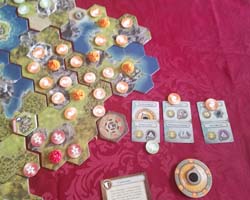
Victory is achieved by completing one objective from each of three objective cards.
Objectively victorious!
A New Dawn also throws out the traditional Civ victory conditions (military, technological, cultural, etc.) in favor of a series of objectives. A set of three objective cards is drawn at the start of the game, and each card has two different objectives. A player wins by completing one objective from each of the cards. This paradigm allows (and requires) players to diversify their civilization a bit more. Instead of having to laser-focus on building a strong military or constructing science infrastructure to power through a tech tree, you can win by creating a balanced civilization. Just how balanced will depend on what particular objective cards are drawn. Of course, the heavily-abstract nature of the board game means that no single system is really complex enough to allow them to be a victory path unto themselves, but I have pitched similar ideas for the computer game, and I think that this board game could be seen as a proof-of-concept.
Despite its few apparent balance issues, this game plays very smoothly and is a lot of fun. As a Civilization PC game veteran, I doubt that A New Dawn will completely supplant the older Civ board game for me, due to that game being a more literal translation of the PC game. If you and your friends can't set aside 5 or 6 hours for a board game, then A New Dawn is probably more up your alley. If your friends have time to go see a movie with you, then they have time to play A New Dawn with you. The quicker pace and simpler mechanics of A New Dawn may also make it more appealing to people who have never played (or don't care for) the PC game, and may even act as a "gateway drug" to get them into Civ in general.
A New Dawn plays much faster and more smoothly than the other Civ board game,
but isn't as literal of a translation of the computer game.
WHAT I LIKE
- Elegant design
- Less downtime than in previous Civ board game
- Much more reasonable game length
- Easy to learn and play
- Barbarians provide a consistent threat
- Victory objectives require diversification
- Civilization abilities and focus set-up suggests a strategy, but you're free to play how you want
WHAT I DON'T LIKE
- Cities don't really do a whole lot
- Civilizations and maps do not feel balanced
- Rules do not clarify the definition of "control"
- Less representative of the computer game
FINAL GRADE: A-
Manufacturer: Fantasy Flight Games
Lead Designer(s): James Kniffen
Original release: November 2017
MSRP: $49.95 USD
Player(s): 2-4 players
Game Length:
the box says 1-2 hours,
but I say 2-4 hours
Official site:
www.fantasyflightgames.com/en/products/
sid-meiers-civilization-a-new-dawn/